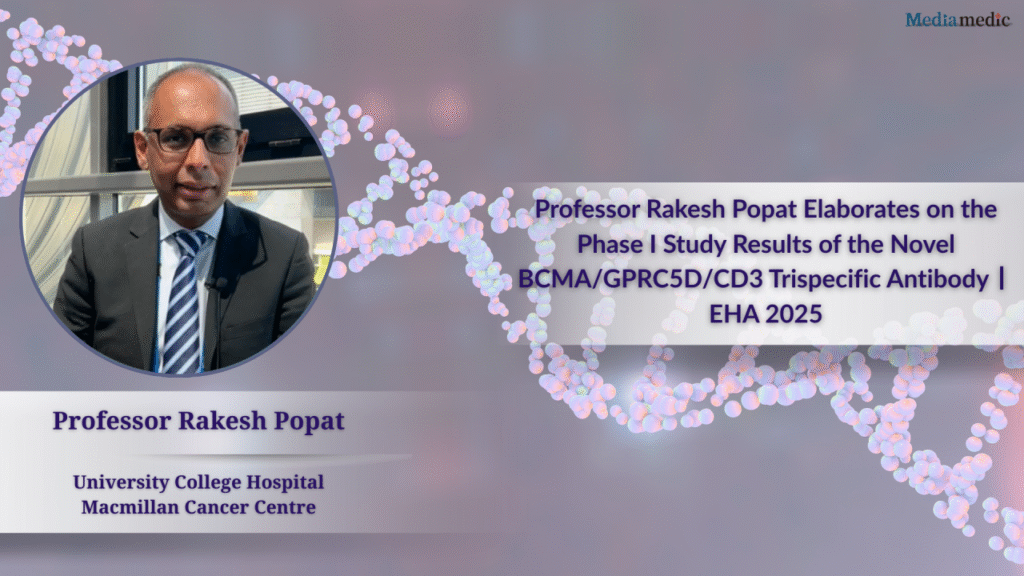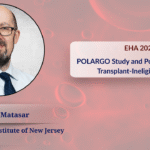
Editor's Note:In 2025, the 30th Annual Congress of the European Hematology Association (EHA) was held in Milan, Italy. As a premier event in the global hematology field, this year's congress attracted thousands of experts and scholars from around the world, with nearly 4,000 abstracts submitted. Among the many studies, a Phase I clinical trial of the novel trispecific antibody JNJ-79635322 (JNJ-5322) (Abstract: S100) was selected by the congress presidency as one of six "outstanding and practice-changing" pivotal studies for an oral presentation during the plenary session, owing to its breakthrough efficacy. The study showcased the astounding potential of JNJ-5322 in treating patients with Relapsed/Refractory Multiple Myeloma (RRMM).The prognosis for RRMM patients who have relapsed after treatment with the three main classes of drugs—proteasome inhibitors, immunomodulatory drugs, and anti-CD38 monoclonal antibodies—is extremely poor. Data from the Locomotion prospective observational study revealed a median Progression-Free Survival (PFS) of only 4.6 months for this patient population, indicating a significant unmet clinical need. In his presentation, Professor Rakesh Popat noted that while CAR-T therapies and bispecific antibodies targeting B-cell maturation antigen (BCMA) or G protein-coupled receptor, class C group 5 member D (GPRC5D) have markedly improved patient outcomes, there remains a need for more effective and less burdensome innovative treatment options.
JNJ-5322: Innovative Tri-specific Targeting Design for a Precise “Double Lockdown” on Myeloma Cells
JNJ-5322 is a structurally novel, next-generation trispecific antibody, distinguished by its three unique binding domains that can simultaneously target two major antigens on the surface of myeloma cells—BCMA and GPRC5D—as well as the CD3 molecule on T-cells. Professor Popat explained, “This antibody binds with high affinity to BCMA and GPRC5D, but with lower affinity to CD3. This design offers multiple advantages.”
Firstly, by concurrently targeting both BCMA and GPRC5D, JNJ-5322 achieves a “double lockdown effect” on myeloma cells, greatly enhancing the avidity and specificity of the antibody-tumor cell interaction. Secondly, this dual-targeting strategy is expected to overcome resistance mechanisms arising from the downregulation or loss of a single antigen, effectively preventing tumor “antigen escape.” [06:04-06:06, 18:58-19:08] Lastly, the low-affinity CD3 binding domain is designed to mitigate T-cell overactivation, thereby leading to a manageable Cytokine Release Syndrome (CRS) profile and improving the treatment’s safety.

Phase I Study Design and Remarkable Efficacy: 100% Objective Response Rate with Deep and Durable Responses
This ongoing Phase I study aims to determine the Recommended Phase 2 Dose (RP2D) of JNJ-5322, evaluate its safety, and provide a preliminary assessment of its efficacy. A total of 147 heavily pretreated RRMM patients were enrolled. The finally determined RP2D was a 5 mg single step-up dose followed by 100 mg administered intravenously every four weeks.
In the 36 patients of the RP2D cohort, the median age was 67 years, and the median number of prior lines of therapy was four. Notably, to clearly assess the drug’s potential in earlier lines of therapy, the study focused on enrolling patients who were naive to both BCMA and GPRC5D targeted treatments.
Efficacy data revealed that at the RP2D (100 mg Q4W), the Overall Response Rate (ORR) reached an astonishing 100% in patients naive to BCMA and GPRC5D targeted therapies. The depth of response was equally impressive, with 96% of patients achieving a Very Good Partial Response (VGPR) or better, and over 70% achieving a Complete Remission (CR). Pharmacokinetic data showed a long half-life of 17 days, supporting the every-four-week dosing schedule.
With a median follow-up of 11.6 months, the 12-month PFS rate in the RP2D cohort was as high as 95%, demonstrating durable disease control. The swimmer plot presented by Professor Popat clearly indicated that the vast majority of patients were still on treatment and maintaining their response, with very few disease progression events.

Safety Analysis: Manageable Toxicity with Significant Potential for Outpatient Treatment
While achieving outstanding efficacy, JNJ-5322 demonstrated a manageable safety profile and good tolerability. CRS is a toxicity of special concern for T-cell redirecting therapies. Data showed that at the RP2D, the incidence of CRS in patients who did not receive prophylactic tocilizumab was 69%, with the majority being Grade 1 and no Grade 3 or higher events. When prophylactic tocilizumab was introduced, the CRS incidence dropped sharply to 20%, with no events of Grade 2 or higher observed, laying a solid foundation for the therapy’s use in an outpatient setting. No cases of neurotoxicity (ICANS) were observed at the RP2D.
Oral toxicities (e.g., dysgeusia, dry mouth) and weight loss associated with GPRC5D-targeted therapies are another clinical challenge. Professor Popat pointed out that JNJ-5322’s performance in this regard was superior to similar bispecific antibodies. The data indicated that related toxicities were predominantly low-grade, and the incidence of weight loss was only 6%, significantly lower than the 30% reported for Talquetamab. In the Q&A session, he added that due to the every-four-week dosing, side effects like dysgeusia often improved before the next dose.
Infections are another adverse event requiring careful management, with a 33.3% incidence of Grade 3 or higher infections in the RP2D cohort. [10:24-10:31] Professor Popat emphasized that with optimized immunoglobulin (IVIG) supplementation and appropriate prophylactic measures, the risk of infection is manageable.

Expert Perspectives and Future Clinical Outlook
During the discussion session, experts in attendance raised further questions about JNJ-5322. When asked if the antibody would still be effective against cells that have downregulated one of the antigens (BCMA or GPRC5D), Professor Popat confirmed, “This is precisely the core advantage of the trispecific targeting design. Even if tumor cells downregulate one of the antigens, the therapy can still achieve cell killing via the other target, which we hope will effectively prevent the development of tumor resistance.”
In summary, Professor Rakesh Popat stated, “At its RP2D, JNJ-5322 has demonstrated a manageable safety profile, an optimized oral toxicity profile, and a very low risk of severe CRS. Its 100% ORR and 95% 12-month PFS rate in BCMA/GPRC5D-naive patients show an efficacy comparable to CAR-T cell therapy. However, as an ‘off-the-shelf’ product, it has immense potential for convenient administration in an outpatient setting, promising to be a transformative treatment option for patients with RRMM.”
The preliminary data on JNJ-5322 presented at this year’s EHA Congress undoubtedly brings new hope to RRMM patients in dire need. As stated by Congress President Martin Dreyling in his opening remarks, these selected studies are true gems capable of “changing the field.” With its innovative design and outstanding data, JNJ-5322 vividly embodies this sentiment, leaving the global hematology community with great anticipation for the future of multiple myeloma treatment.


